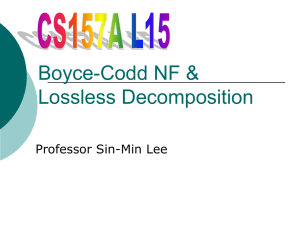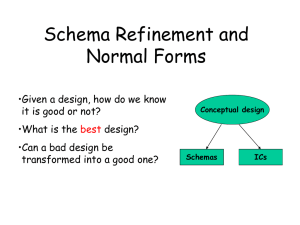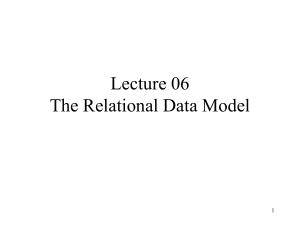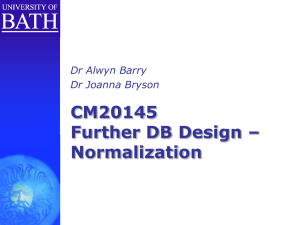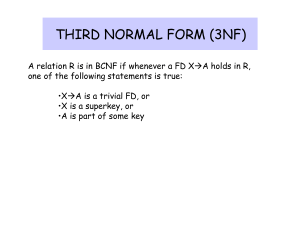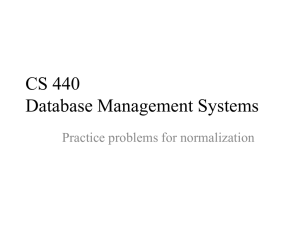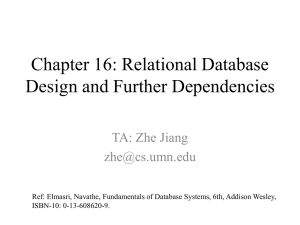Database Systems Lecture #5
advertisement
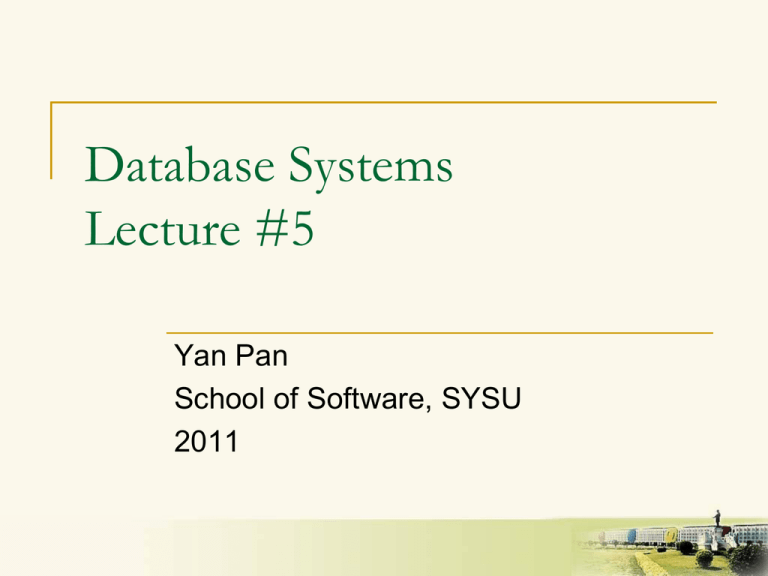
Database Systems
Lecture #5
Yan Pan
School of Software, SYSU
2011
Agenda
Last time: FDs
This time:
Anomalies
Normalization: BCNF & 3NF
Next time: RA & SQL
1.
2.
2
Review: FDs
Definition:
If two tuples agree on the attributes
A1, A2, …, An
then they must also agree on the attributes
B1, B2, …, Bm
3
Notation: A1, A2, …, An B1, B2, …, Bm
Read as: Ai functionally determines Bj
Review: Combining FDs
If some FDs are satisfied, then
others are satisfied too
If all these FDs are true:
name color
category department
color, category price
Then this FD also holds: name, category price
Why?
4
Problem: find all FDs
Given a relation instance and set of given FDs
Find all FD’s satisfied by that instance
Useful if we don’t get enough information from our
users: need to reverse engineer a data instance
Q: How long does this take?
A: Some time for each subset of atts
Q: How many subsets?
5
powerset
exponential time in worst-case
But can often be smarter…
Closure Algorithm
Start with X={A1, …, An}.
Repeat:
B1, …, Bn C is a FD and
B1, …, Bn are all in X
then add C to X.
if
until X didn’t change
6
Example:
name color
category department
color, category price
{name, category}+ =
{name, category, color,
department, price}
Closure alg e.g.
Example:
A, B C
A, D B
B
D
Compute X+, for every set X (AB is shorthand for {A,B}):
A+ = A, B+ = BD, C+ = C, D+ = D
AB+ = ABCD, AC+ = AC, AD+ = ABCD, BC+ = BC, BD+ = BD, CD+ = CD
ABC+ = ABD+ = ACD+ = ABCD (no need to compute–why?)
BCD+ = BCD, ABCD+ = ABCD
What are the keys?
7
Closure alg e.g.
In class:
A, B
A, D
B
A, F
R(A,B,C,D,E,F)
Compute {A,B}+
X = {A, B,
}
Compute {A, F}+
X = {A, F,
}
What are the keys?
8
C
E
D
B
Closure alg e.g.
Product(name, price, category, color)
name, category price
category color
FDs are:
Keys are:
{name, category}
Enrollment(student, address, course, room, time)
student address
room, time course
student, course room, time
FDs are:
Keys are:
9
Next topic: Anomalies
Identify anomalies in existing schemata
Decomposition by projection
BCNF
Lossy v. lossless
Third Normal Form
10
Types of anomalies
Redundancy
Update anomalies:
Delete some values & lose other values too
Insert anomalies:
11
Change info in one tuple but not in another
Deletion anomalies:
Repeat info unnecessarily in several tuples
Inserting row means having to insert other, separate info /
null-ing it out
Examples of anomalies
Name
SSN
Mailing-address
Phone
Michael
123
NY
212-111-1111
Michael
123
NY
917-111-1111
Hilary
456
DC
202-222-2222
Hilary
456
DC
914-222-2222
Bill
789
Chappaqua
914-222-2222
Bill
789
Chappaqua
212-333-3333
SSN Name, Mailing-address
Redundancy: name, maddress
Update anomaly: Bill moves
Delete anom.: Bill doesn’t pay bills, lose phones lose Bill!
Insert anom: can’t insert someone without a (non-null) phone
Underlying cause: SSN-phone is many-many
Effect: partial dependency ssn name, maddress,
12
SSN Phone
Whereas key = {ssn,phone}
Decomposition by projection
Soln: replace anomalous R with projections of R onto
two subsets of attributes
Projection: an operation in Relational Algebra
Projecting R onto attributes (A1,…,An) means
removing all other attributes
13
Corresponds to SELECT command in SQL
Result of projection is another relation
Yields tuples whose fields are A1,…,An
Resulting duplicates ignored
Projection for decomposition
R(A1, ..., An, B1, ..., Bm, C1, ..., Cp)
R1(A1, ..., An, B1, ..., Bm)
R2(A1, ..., An, C1, ..., Cp)
R1 = projection of R on A1, ..., An, B1, ..., Bm
R2 = projection of R on A1, ..., An, C1, ..., Cp
A1, ..., An B1, ..., Bm C1, ..., Cp = all attributes
R1 and R2 may (/not) be reassembled to produce original R
14
Decomposition example
Break
the
relation
into
two:
Name
SSN
Mailing-address
Phone
Michael
123
NY
212-111-1111
Michael
123
NY
917-111-1111
Hilary
456
DC
202-222-2222
Hilary
456
DC
914-222-2222
Bill
789
Chappaqua
914-222-2222
Bill
789
Chappaqua
212-333-3333
Name
SSN
Mailing-address
SSN
Phone
Michael
123
NY
123
212-111-1111
Hilary
456
DC
123
917-111-1111
Bill
789
Chappaqua
456
202-222-2222
The anomalies are gone
456
914-222-2222
789
914-222-2222
789
212-333-3333
15
No more redundant data
Easy to for Bill to move
Okay for Bill to lose all phones
Thus: high-level strategy
name
E/R Model:
Product
price
Relational Model:
plus FD’s
Normalization:
Eliminates anomalies
16
Person
buys
name
ssn
Using FDs to produce good schemas
Start with set of relations
Define FDs (and keys) for them based on real
world
Transform your relations to “normal form”
(normalize them)
1.
2.
3.
Intuitively, good design means
17
Do this using “decomposition”
No anomalies
Can reconstruct all (and only the) original information
Decomposition terminology
Projection: eliminating certain atts from relation
Decomposition: separating a relation into two by
projection
Join: (re)assembling two relations
If exactly the original rows are reproduced by joining
the relations, then the decomposition was lossless
18
Whenever a row from R1 and a row from R2 have the same
value for some atts A, join together to form a row of R3
We join on the attributes R1 and R2 have in common (As)
If it can’t, the decomposition was lossy
Lossless Decompositions
A decomposition is lossless if we can recover:
R(A,B,C)
Decompose
R1(A,B)
R2(A,C)
Recover
R’(A,B,C) should be the same as
R(A,B,C)
R’ is in general larger than R. Must ensure R’ = R
19
Lossless decomposition
20
Sometimes the same set of data is reproduced:
Name
Price
Category
Word
100
WP
Oracle
1000
DB
Access
100
DB
Name
Price
Name
Category
Word
100
Word
WP
Oracle
1000
Oracle
DB
Access
100
Access
DB
(Word, 100) + (Word, WP) (Word, 100, WP)
(Oracle, 1000) + (Oracle, DB) (Oracle, 1000, DB)
(Access, 100) + (Access, DB) (Access, 100, DB)
Lossy decomposition
21
Sometimes it’s not:
Name
Price
Category
Word
100
WP
Oracle
1000
DB
Access
100
DB
What’s
wrong?
Category
Name
Category
Price
WP
Word
WP
100
DB
Oracle
DB
1000
DB
Access
DB
100
(Word, WP) + (100, WP) (Word, 100, WP)
(Oracle, DB) + (1000, DB) (Oracle, 1000, DB)
(Oracle, DB) + (100, DB) (Oracle, 100, DB)
(Access, DB) + (1000, DB) (Access, 1000, DB)
(Access, DB) + (100, DB) (Access, 100, DB)
Ensuring lossless decomposition
R(A1, ..., An, B1, ..., Bm, C1, ..., Cp)
R1(A1, ..., An, B1, ..., Bm)
R2(A1, ..., An, C1, ..., Cp)
If A1, ..., An B1, ..., Bm or A1, ..., An C1, ..., Cp
Then the decomposition is lossless
Note: don’t need both
22
Examples:
name price, so first decomposition was lossless
category name and category price, and so second
decomposition was lossy
Quick lossless/lossy example
X
1
4
Y
2
2
Z
3
5
At a glance: can we decompose into R1(Y,X), R2(Y,Z)?
At a glance: can we decompose into R1(X,Y), R2(X,Z)?
23
Next topic: Normal Forms
First Normal Form = all attributes are atomic
As opposed to set-valued
Assumed all along
Second Normal Form (2NF)
Third Normal Form (3NF)
Boyce Codd Normal Form (BCNF)
Fourth Normal Form (4NF)
Fifth Normal Form (5NF)
24
BCNF definition
A simple condition for removing anomalies from
relations:
A relation R is in BCNF if:
If As Bs is a non-trivial dependency
in R , then As is a superkey for R
I.e.: The left side must always contain a key
I.e: If a set of attributes determines other attributes,
it must determine all the attributes
Slogan: “In every FD, the left side is a superkey.”
25
BCNF decomposition algorithm
Repeat
choose A1, …, Am B1, …, Bn that violates the BNCF condition
//Heuristic: choose Bs as large as possible
split R into R1(A1, …, Am, B1, …, Bn) and R2(A1, …, Am, [others])
continue with both R1 and R2
Until no more violations
B’s
R1
26
A’s
Others
R2
Boyce-Codd Normal Form
Name/phone example is not BCNF:
Name
SSN
Mailing-address
Phone
Michael
123
NY
212-111-1111
Michael
123
NY
917-111-1111
{ssn,phone} is key
FD: ssn name,mailing-address holds
Violates BCNF: ssn is not a superkey
Its decomposition is BCNF
Only superkeys anything else
Name
SSN
Mailing-address
SSN
PhoneNumber
Michael
123
NY
123
212-111-1111
123
917-111-1111
27
BCNF Decomposition
Larger example: multiple decompositions
{Title, Year, Studio, President, Pres-Address}
FDs:
No many-many this time
Problem cause: transitive FDs:
28
Title, Year Studio
Studio President
President Pres-Address
=> Studio President, Pres-Address
Title, year studio president
BCNF Decomposition
Illegal: As Bs, where As not a superkey
Decompose: Studio President, Pres-Address
Result:
1.
2.
Studios(studio, president, pres-address)
Movies(studio, title, year)
Is (2) in BCNF? Is (1) in BCNF?
29
As = {studio}
Bs = {president, pres-address}
Cs = {title, year}
Key: Studio
FD: President Pres-Address
Q: Does president studio? If so, president is a key
But if not, it violates BCNF
BCNF Decomposition
Studios(studio, president, pres-address)
Illegal: As Bs, where As not a superkey
Decompose: President Pres-Address
{Studio, President, Pres-Address} becomes
30
As = {president}
Bs = {pres-address}
Cs = {studio}
{President, Pres-Address}
{Studio, President}
Decomposition algorithm example
31
R(N,O,R,P)
F = {N O, O R, R N}
Name
Office
Residence
Phone
George
Pres.
WH
202-…
George
Pres.
WH
486-…
Dick
VP
NO
202-…
Dick
VP
NO
Key: N,P
Violations of BCNF: N O, OR, N OR
Pick N OR
Can we rejoin?
What happens if we pick N O instead?
Can we rejoin?
307-…
An issue with BCNF
We could lose FDs
Relation: R(Title, Theater, Neighboorhood)
FDs:
Title,N’hood Theater
Assume a movie shouldn’t play twice in same n’hood
Theater N’hood
Keys:
Title
Theater
{Title, N’hood}
Aviator
Angelica
{Theater, Title}
Life Aquatic Angelica
32
N’hood
Village
Village
Losing FDs
BCNF violation: Theater N’hood
Decompose:
{Theater, N’Hood}
{Theater, Title}
Resulting relations:
R1
R2
Theater
N’hood
Theater
Title
Angelica
Village
Angelica
Angelica
Aviator
Life Aquatic
33
Losing FDs
Suppose we add new rows to R1 and R2:
R1 Theater
N’hood
R2 Theater
Title
Angelica
Village
Angelica
Life Aquatic
Film Forum
Village
Angelica
Aviator
Film Forum
Life Aquatic
R’
34
Theater
N’hood
Title
Angelica
Village
Life Aquatic
Angelica
Village
Aviator
Film Forum
Village
Life Aquatic
Neither R1 nor R2 enforces FD Title,N’hood Theater
Third normal form: motivation
Sometimes
In these cases BCNF is too severe a req.
“over-normalization”
Solution: define a weaker normal form, 3NF
35
BCNF is not dependency-preserving, and
Efficient checking for FD violation on updates is important
FDs can be checked on individual relations without
performing a join (no inter-relational FDs)
relations can be converted, preserving both data and FDs
BCNF lossiness
NB: BCNF decomp. is not data-lossy
But: it can lose dependencies
36
Results can be rejoined to obtain the exact original
After decomp, now legal to add rows whose corresponding
rows would be illegal in (rejoined) original
Data-lossy v. FD-lossy
Third Normal Form
Now define the (weaker) Third Normal Form
Turns out: this example was already in 3NF
A relation R is in 3rd normal form if :
For every nontrivial dependency A1, A2, ..., An B
for R, {A1, A2, ..., An } is a super-key for R,
or B is part of a key, i.e., B is prime
Tradeoff:
BCNF = no FD anomalies, but may lose some FDs
3NF = keeps all FDs, but may have some anomalies
37
Canonical Cover
Consider a set F of functional dependencies and the functional dependency
in F.
From A C
A canonical coverFc for F is a set of dependencies such that F logically
implies all dependencies in Fc and Fc logically implies all dependencies in F,
and further
38
Attribute A is extraneous in if A and if A is removed from , the Iset
getofAB C
functional dependencies implied by F doesn’t change.
Given AB C and A C then B is extraneous in AB
Attribute A is extraneous in if A and if A is removed from , the set of
functional dependencies implied by F doesn’t change.
Given A BC and A B then B is extraneous in BC
No functional dependency in Fc contains an extraneous attribute.
Each left side of a functional dependency in Fc is unique.
Canonical Cover
39
Compute a canonical over for F:
repeat
use the union rule to replace any
dependencies in F
1 1 and 1 2 replaced with 1
12
Find a functional dependency
with an
extraneous attribute
either in or in
If an extraneous attribute is found, delete
it from
until F does not change
Example of Computing a Canonical Cover
40
R = (A, B, C)
F = { A BC
B C
A B
AB C}
Combine A BC and A B into A
BC
A is extraneous in AB C because B
C logically implies AB C.
C is extraneous in A BC since A
BC is logically implied by A B and B
C.
The canonical cover is:
AB
BC
A BC
B C
AB C
A BC
B C
B C
A BC
B C
A B
B C
3NF Decomposition Algorithm
41
Let Fc be a canonical cover for F;
i := 0;
for each functional dependency in Fc do
if none of the schemas Rj, 1<= j <= i contains
then begin
i:=i+1;
Ri:= ;
end
if none of the schemas Rj, 1<= j <= i contains a candidate key for R
then begin
i:=i+1;
Ri:= any candidate key for R;
end
return (R1, R2, …, Ri)
Example
Relation schema:
Banker-info-schema
branch-name, customer-name, banker-name, office-number
42
The functional dependencies for this
relation schema are:
banker-name branch-name, officenumber
customer-name, branch-name
banker-name
The key is:
{customer-name, branch-name}
Applying 3NF to banker - info schema
Go through the for loop in the algorithm:
banker-name branch-name, office-number
is not in any decomposed relation (no decomposed relation so
far)
Create a new relation:
Banker-office-schema ( banker-name, branch-name, office-number )
customer-name, branch-name banker-name
is not in any decomposed relation (one decomposed relation so
far) Create a new relation:
Banker-schema ( customer-name, branch-name, banker-name )
43
Since Banker-schema contains a candidate key for Banker-infoschema, we are done with the decomposition process.
Comparison of BCNF and 3NF
It is always possible to decompose a relation
into relations in 3NF and
It is always possible to decompose a relation
into relations in BCNF and
44
the decomposition is lossless
dependencies are preserved
the decomposition is lossless
it may not be possible to preserve dependencies
Next week
45
Read ch.5.1-2 (SQL)
